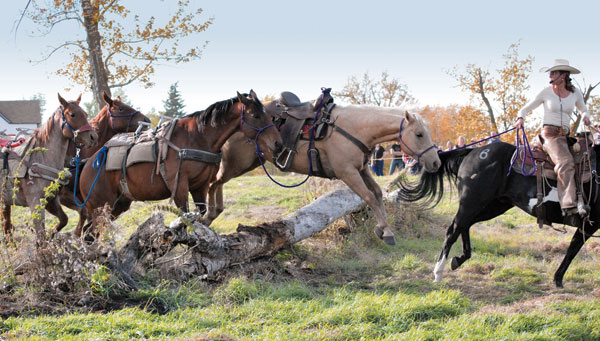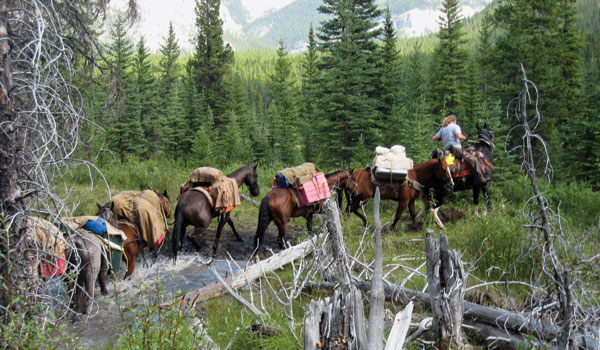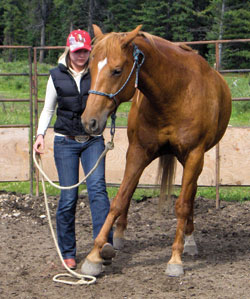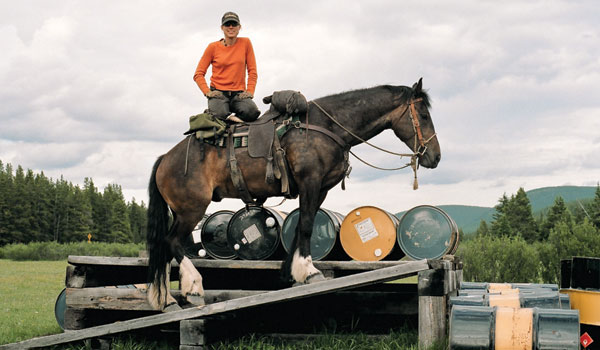Mountain Horses May Save Your Life
 |
| Roundup cowboys near High River, Alta., ca. 1901. Walter Watt (front row, fifth from left on white horse) was appointed the captain of the Mosquito Creek wagon on the general roundup in southern Alberta. By 1902, Watt was Captain of the general roundup. Photo by Darla Rathwell |
To truly understand the value of a good mountain horse, I need to paint you a picture. Life in the backcountry is something few people will experience; few will be able to understand. For those of you who have been there — you know.
Often, you won’t see another soul for days. You and your horse face a great variety of terrain — from flat, open meadows to steep rocky cliffs, brush-choked forest, or horse-burying bog. You encounter lots of wildlife: deer, elk, moose, bear and cougars. You’re constantly at the mercy of Mother Nature who, like a woman, likes to change her mind on a whim. You’re also miles from civilization — and help — if either you or your horse is injured.
 |
| Wild Deuce wrangler, Heidi, guides her string of pack horses some 20 miles into the mountains |
Life in the mountains can be a matter of life or death. Contrary to popular belief, a mountain horse is not “just a trail horse.” By true definition, a mountain horse is much more remarkable. A good mountain horse needs to be able to think. We call it “creating the thinking horse.” He must be able to go against his instinctual desire to flee in the face of danger — and to put total trust in his rider/companion, as well as his own abilities, regardless of the situation.
Also contrary to popular belief, the “pack horse” may be your most important mount when in the wilderness, even over your riding horse. You can walk or hike to get where you’re going, but having an animal to carryall your gear is sure a luxury! The pack horse will carry your gear and food safely through a myriad of terrain without breakage. While it’s true you can survive for days on water alone, food is sure nice, as are clean clothes, shelter and a sleeping bag. If a pack horse goes lame or is injured, you may be stuck in camp for days, immobilized. So it’s just as important that your pack horse be able to “think” and not do anything to jeopardize himself, his teammates, or you.
Training a mountain horse begins from the ground up. Forging a trusting partnership begins long before you get on their back. This is the least important aspect of training for us, because by the time we get on their backs to ride, it’s the easiest and most boring time. Those horses already know our body language and voice cues and have established trust and respect for us. Our first ride is usually just to get on and walk away. The most important aspects of training happen before this. Just as a child’s initial learning is so crucial in the first five years of life, so is a horse’s first steps of training, to lay the foundation for all that is to come.
 |
 |
| Sometimes a ladder isn’t available, but a good horse is. Brenda and her horse, Stella, work to re-tie a highline in camp in the back country by 40 Mile. |
A clinic participant practises communicating with her horse at Wild Deuce base camp west of Rocky Mountain House Photos courtesy Wild Deuce |
Some key aspects to laying a good foundation are:
Time
Developing a good mountain horse takes time. It’s not just about going riding or being on its back, it’s about spending time.
Communication
Establish body language that you and your horse both understand. Understanding how a horse thinks and behaves is key. You need to be able to communicate clearly with your horse.
Voice Commands
Especially in the backcountry, being able to communicate
verbally to your horse is important. Riding on the side of a steep cliff on a nervous horse and calming him with your voice, or having a pack string of 11 horses and being able to talk to the ninth one in line is pretty cool — and it can also save lives.
Leadership
Decide who is Alpha. YOU need to be a leader to your horse. A confident, clear and fair leader is someone your horse will want to follow. When you find yourself in a situation or landscape that’s unfamiliar or even scary to your horse, the horse needs to look to you for direction instead of going back to his natural instinct to flee.
Respect and trust
Create an environment for mutual respect and trust. Every situation you encounter will come down to this: Does your horse respect and trust you? Being able to communicate clearly to your horse, and showing that you’re a responsible leader, is the start of a good relationship.
Teamwork
Learn to work as an individual — and as a team. A mountain horse must develop his skills, operating on his own, as well as be aware of what’s going on around him.
Stimulate
Introduce your horse to new things and situations. If you lead him through them safely and calmly, you’ll increase your horse’s confidence in himself and your leadership.
In the backcountry, we rely on our horses for survival as much as they rely on us. This unique partnership
between the two of you cannot be created elsewhere. With the phenomenal foundation that a mountain horse gets, their mind is balanced; they easily adapt to new surroundings, situations and requirements.
Thanks to their exposure to so many diverse elements and experiences, a true mountain horse is going to be a good, reliable mount — no matter where you ride.
 |
| Riding a training horse, Brenda tries a new obstacle out West at a helicopter fuel cache site |
Brenda Murdock and her business partner, Terri McKinney, operate Wild Deuce Retreats & Outfitting; training horses, teaching horsemanship and guiding pack trips in the Rockies. For more info, visit www.wilddeuce.com
















